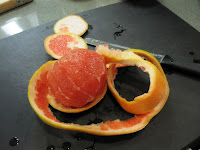Orange and Black Currant Scones
These scones have lots of flavor and interest without being overly sweet.
2 cups flour
1½ tablespoons sugar plus sugar for sprinkling
1 teaspoons baking powder
1 teaspoons baking soda
1 teaspoon salt
½ cup (1 stick) butter, diced
Grated zest of 1 orange
1 egg
¾ cup buttermilk
¾ cup dried black currants
1. Combine the flour, sugar, baking powder, baking soda and salt in a large bowl. Mix well. With a pastry cutter or your fingers, cut in the butter and orange zest until the mixture resembles coarse meal. You an also do this step in a food processor.
2. Whisk together the egg and buttermilk in a small measuring pitcher or bowl. Pour over the dry ingredients and sprinkle on the currants. Stir just until the ingredients come together and form a soft ball. Do not over mix. Tip out the dough onto a floured board.
3. Divide the dough into 8 pieces, patting them into rounds with floured hands. Place them 1 inch apart on an ungreased baking sheet. Refrigerate for 15 minutes or up to overnight.
4. Preheat the oven to 375°F.
5. Sprinkle each scone with about ¼ teaspoon sugar, either regular or coarse.
6. Bake the chilled scones until lightly browned on top, about 20 minutes. Cool on a rack. Serve at room temperature or warm. They are best eaten the same day they are made.
Makes 8
Adapted from Judy Wicks and Kevin Von Klause’s White Dog Café Cookbook
Lemon Love Notes
There are many different recipes for what is traditionally in the South called Lemon Squares. What I like best about this recipe is its name. Isn’t that just wonderful? In addition, they are just lusciously delicious.
Crust:
½ cup (1 stick) butter, at room temperature
1 cup flour
¼ cup sugar
¼ teaspoon salt
1. Mix all ingredients in a food processor, with a mixer or with your hands.
2. Pat into a well-greased 9x9 or 9x11 pan (for a thinner crust). Bake 15 minutes in 350ºF oven until the crust is a light brown. Cool slightly.
Topping:
3 eggs
1 cup sugar
3 tablespoons flour
¾ teaspoon baking powder
½ teaspoon salt
Zest from 2 lemons
Juice from 2 lemons
Confectioners’ sugar to dust
1. If you’ve used a food processor to make the crust, don’t bother to wash it before you do this next step. Process or beat eggs until light; beat in sugar, adding slowly. Mix in the rest of the ingredients and pour into the pan.
2. Bake in 350ºF oven for 25 minutes or until the topping is set.
3. When cool, sprinkle with confectioners’ sugar. If your confectioners’ sugar is lumpy, put a small amount in a sieve and sprinkle it over the squares, squashing the lumps through the sieve with your fingers. Cut into squares with a wet knife.
Makes 16-20 squares in a 9x9 pan.
Adapted from Of Pots and Pipkins: Recipes from the Junior League of Roanoke Valley, Virginia
Royal Grapefruit Sorbet
3 large pink grapefruits
3 tablespoons honey (in liquid form)
Black pepper, if desired
1. Remove and discard peels from the grapefruits. See instructions below. Place in a single layer on a microwave-proof dish or a cookie sheet lined with wax paper and freeze for three hours or overnight until solid.
2. Microwave on defrost for 1 minute if you used the microwaveable dish. The sections should be just slightly thawed. If you used a cookie sheet, transfer a single layer of the frozen segments to a plate and defrost for 1 minute; you may need to do 2 batches.
3. If your sections are big, break them up into smaller pieces. Place in a food processor and pulse until finely chopped. Add the honey and process until smooth. You may have to do this process in batches depending on the size of your machine. Place sorbet in a container and return to the freezer for a few hours or until serving time.
4. Scoop into bowls or serve on top of fresh fruit salad. For a spicy note, sprinkle with ground black pepper, if desired.
Note: If sorbet becomes too hard to scoop, microwave on defrost for one minute. It will keep in freezer for two weeks.
5-6 servings (about 3 cups)
Adapted from brochure from Harry and David’s Fruit of the Month Club Brochure
Sectioning Citrus
1. Cut off both ends of the grapefruit or other citrus fruit.
 2. With a serrated knife, cut a strip around the top of the grapefruit, using a sawing motion. Keep moving down and around the grapefruit until you have reached the bottom. The hope is the remove the skin and the white pith without removing too much of the precious flesh of the fruit. If you have missed any of the pith, cut it off.
2. With a serrated knife, cut a strip around the top of the grapefruit, using a sawing motion. Keep moving down and around the grapefruit until you have reached the bottom. The hope is the remove the skin and the white pith without removing too much of the precious flesh of the fruit. If you have missed any of the pith, cut it off.3. Cut the sections by cutting along one side of the membrane and then on the other side of the membrane. Slide out the section. Best to do this step over a bowl to catch the juice.
4. Continue around the grapefruit until you have removed all the grapefruit sections. Squeeze the bundle (bottom right) of membranes to get more juice which you get to drink as a reward.





























